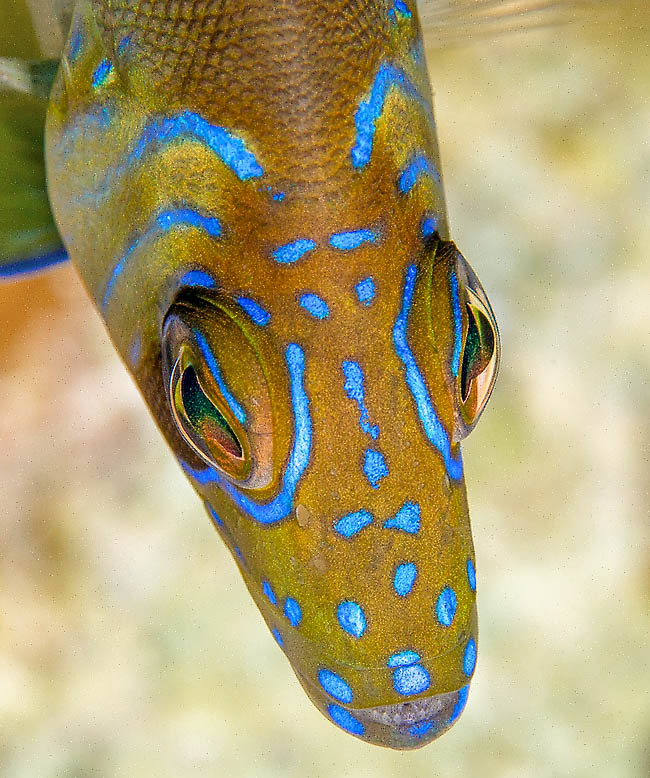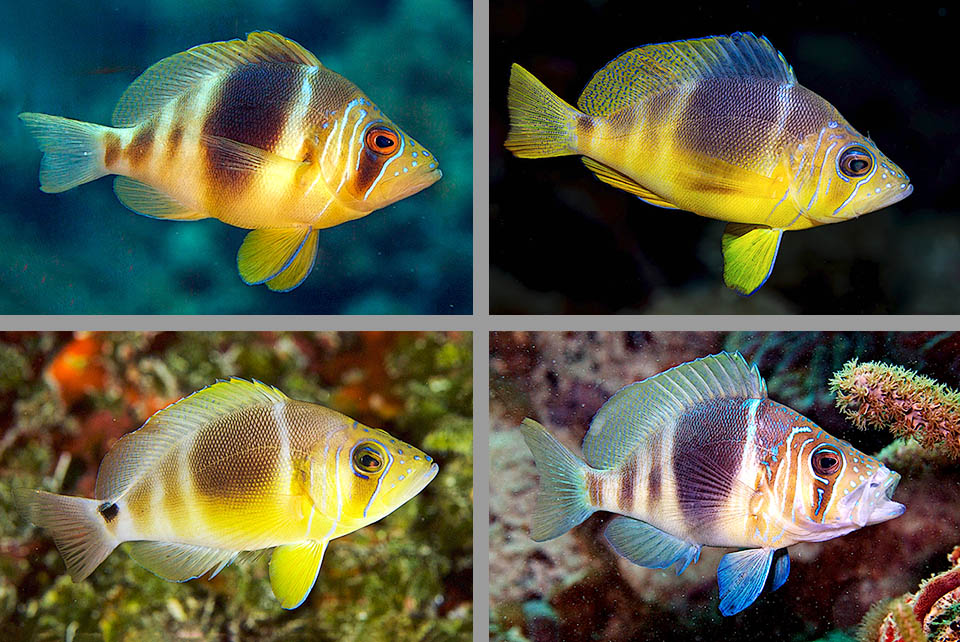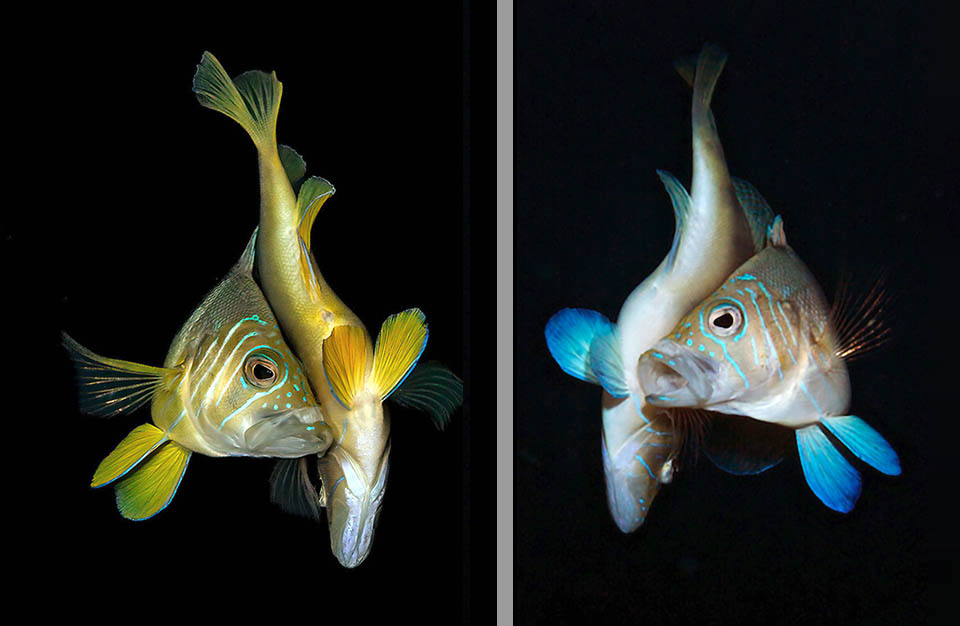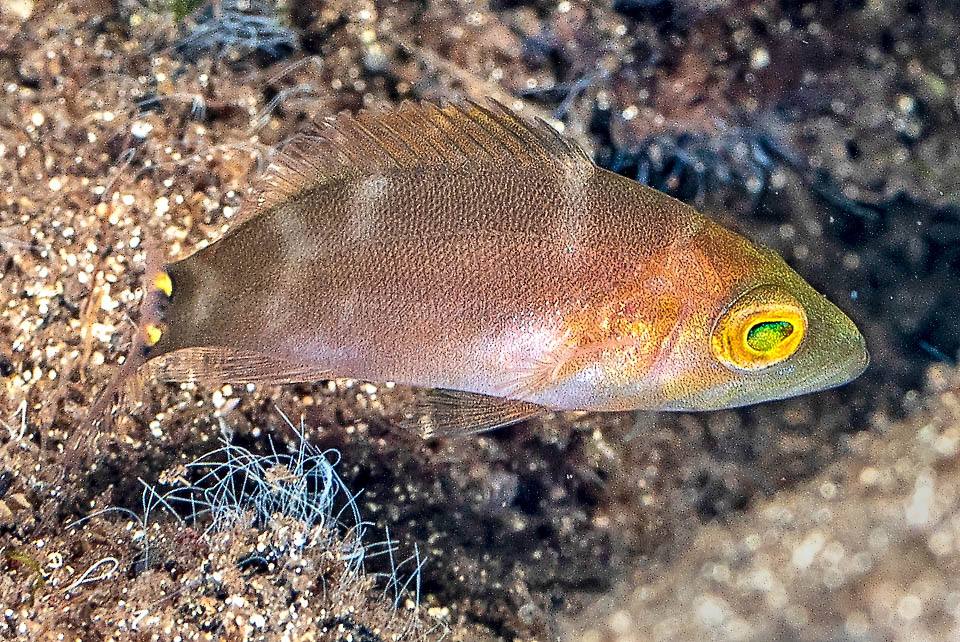Family : Serranidae

Text © Giuseppe Mazza

English translation by Mario Beltramini

Ornate eyes nice girl as states the specific name, Hypoplectrus puella is a small Caribbean grouper known as Barred Hamlet. Particularly thin, he manages to reach fish and crustaceans in the cracks where other groupers cannot enter © www.carlosestape.photoshelter.com
Near giants like Epinephelus itajara, that reaching the length of 2,5 m and the incredible weight of 455 kg, the Caribbean is home to mini groupers like Cephalopholis fulva, usually 25 cm long or Hypoplectrus puella, even smaller, reaching a maximum of 15,2 cm and above all is thinner.
So it can slip into the cracks of the rocks, not only to possibly get shelter, but especially for preying on the small fish the other groupers are unable to catch.
It belongs, like them, to the class of the Actinopterygii, the ray-finned fish, to the order of the Perciformes and to the family of the Serranidae.
The genus Hypoplectrus originates formed by the Greek “ipo”, below, and “plettro”, spur, with possible reference to the serrations on the edge of the angular preoperculum and to the small spines pointing forward on the lower margin, whilst the specific term puella, girl in Latin, might make think due to the blue lines, artfully located next to the eyes, to the ambitious make-up of a young girl.
Zoogeography
Hypoplectrus puella is present in the central-western Atlantic: from Bermuda and the Gulf of Mexico up to the entire Caribbean.
Ecology-Habitat
It lives associated with the coral reef and to rocky environments, between 3 and 23 m of depth where the temperature fluctuates between 25,3 and 28,2 °C.
Morphophysiology
The relatively short snout has the protractile upper jaw with flesh lips and fixed teeth, that is born in a certain position and are kept as such for life without being replaced.
The dorsal fin has 10 spiny rays and 14-16 soft; the anal 3 spines and 7 unarmed rays; the pelvic ones, well developed, exceed in length also the anus and may be yellow, white or blue, whilst the pectoral fins are clear translucent. The caudal is slightly forked.

The livery often displays different colours depending on sites, but are always present 6 vertical brown bars © www.carlosestape.photoshelter.com
The livery of Hypoplectrus puella is often depending on the locations. The body, cream white or pale yellow however displays 6 brown vertical bars. The first crosses the eye, the second is on the nape, and the third, quite wide, narrows to a “V” downwards. The remaining ones, parallel and evenly spaced, reach the caudal peduncle.
Ethology-Reproductive Biology
Hypoplectrus puella lives mainly solitary, feeding usually towards evening on fish and crustaceans. Often, taking advantage of its lively colours, it is associated with the multi-coloured parrotfish, notoriously herbivorous, like the Sparisoma viride. The little fish swimming next to it do not fear them, let them get close, and they take advantage of this pouncing on them with quick darts.

Hypoplectrus puella is a synchronous oviparous hermaphroditic fish, both adults having at same time male and female gonads. It has been noted that matings usually occur between fish with the same colours and now some researchers venture the hypothesis that they could also be different species © www.carlosestape.photoshelter.com
Hypoplectrus puella is a synchronous hermaphroditic oviparous fish: which means that both adults have at the same time the male and female gonads. In the love dance the one who plays the rôle of the male embraces the female, and both rise in the water column to release the gametes. When these have well dispersed, then they may reverse the rôles, sure to avoid the self-fertilization.
In the choice of the partner, they display a clear preference for those belonging to the same variant of colour, and therefore presently there are those proposing to consider them as different species.
But the characters uniting them are quite more numerous than those dividing them, and so some suggest the name of Hypoplectrus unicolor and our mini grouper would then become Hypoplectrus unicolor var. puella.

Juvenile. Species resilience is mediocre, the fishing vulnerability is very low, and in any case it is not an endangered species © www.carlosestape.photoshelter.com
The resilience of the species is mediocre with a minimum time for the doubling of the populations of 1,4-4,4 years.
The fishing vulnerability index, very low, marks only 10 on a scale of 100.
Consequently since 2012 Hypoplectrus puella appears as “LC, Least Concern”, in the IUCN Red List of the endangered species.
Synonyms
Plectropoma puella Cuvier, 1828; Plectropoma vitulinum Poey, 1852; Hypoplectrus vitulinus (Poey, 1852).
→ For general information about FISH please click here.
→ For general information about BONY FISH please click here
→ For general information about CARTILAGINOUS FISH please click here.
→ To appreciate the BIODIVERSITY of BONY FISH please click here.
→ To appreciate the BIODIVERSITY of CARTILAGINOUS FISH please click here.
